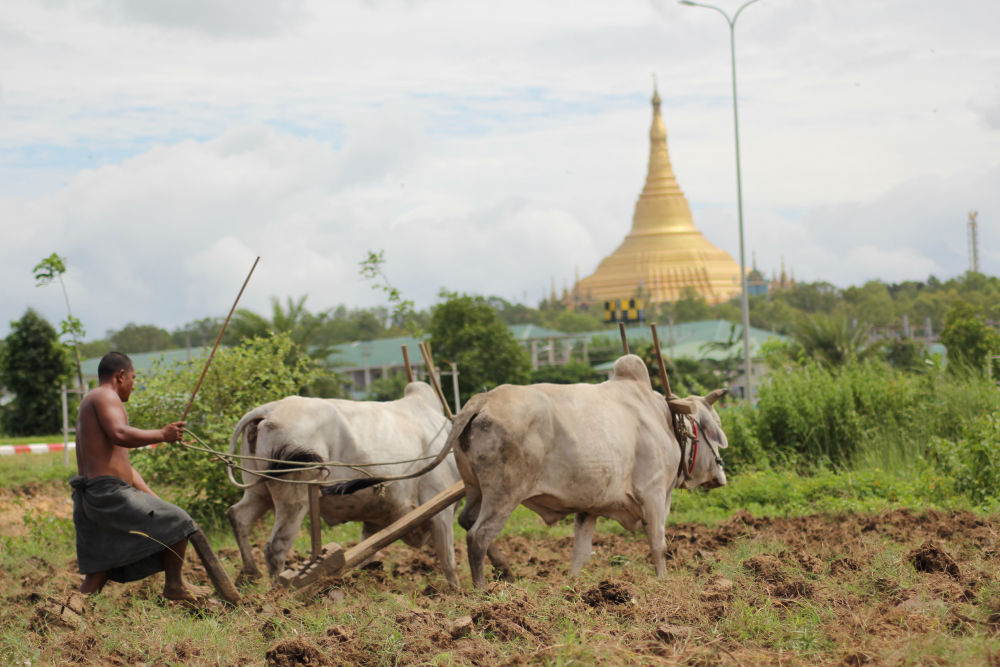By Phyo Thiha Cho/ Myanmar Now
ZALUN Township, Ayeyarwady Region — Aung Kywe remembers how he had to stand by helplessly last year when massive floods in the wake of Cyclone Komen affected Ayeyarwady Delta and destroyed half of his 14 acres of paddy.
That traumatic experience came on top of years of decreasing yields, Aung Kywe said, adding that this monsoon season he will leave much of his land in Kawkatkyi Village, Zalun Township, fallow to avoid loss of money with another failed harvest.
“Paddy plots on the lower-lying land are almost sure to be flooded,” he said, adding, “Paddy yields have also decreased year by year, from 100 baskets per acre to 75 baskets.” A basket of rice weighs around 25 kilograms.
In neighbouring Maubin Township, also located in the heart of Myanmar’s ‘rice bowl’ delta region, farmers spoke of similar measures to limit exposure to what many believe are increased occurrences of climate change-related extreme weather, such as drought, heat and floods.
Kyaw Minn, from Palaung village, said, “I will not grow monsoon paddy this year, but will cultivate other seasonal crops when the water level drops after the rainy season.”
Farmers in the delta generally grow two rice crops, one in the rainy season and one in the cooler season in lower-lying areas that are fed with receding flood waters. They might also grow a third, short-cycle crop, such as beans, in the hot months before the monsoon.
Thein Aung, chairman of the Independent Farmers League in Ayeyawady Region, said that because of rising concerns among farmers vast areas of land will go uncultivated this year.
“The farmers from our villages will not be growing paddy in a total of 200,000 acres situated on the low lands,” he said, before adding that the impact on overall paddy production would probably be limited as these fields are some of the least-productive tracts.
The Ayeyarwady Delta is home to many millions of subsistence farmers whose income and food security relies on their annual harvest, and to a lesser extent fishing.
The drop in rice production follows the devastating impact of Cyclone Komen, which ravaged the farm sector with heavy flooding in 12 out of 14 states and regions from June to August last year.
Some 260,000 acres of monsoon paddy fields were flooded and 52,000 acres damaged, according to official figures, which showed that the cyclone killed 120 people and affected more than 400,000 households.
Sein Win Hlaing, chairman of the Paddy and Rice Producers Association, said, “Rice production declined by 20 percent last year due to the weather’s impact.” He added that the fall in rice production would hamper Myanmar’s export, which stood at around 1.5 million metric tons of rice before 2015.
Cyclones and other extreme weather are set to increase further and this trend should ring alarm bells with the agriculture sector and the new National League for Democracy government, said Tun Lwin, an independent meteorological expert and former government official.
“Traditional agricultural methods are no longer suitable for the changing weather conditions,” he warned, adding that the monsoon would be shorter and produce more volatile weather.
Ba Hein, the Minister for Agriculture, Livestock, Natural Resources for Ayeyawady Region, said development of the agriculture sector and of the water management infrastructure was ignored by previous, military-led governments.
“The delta has many rivers and streams, and these have not been properly managed,” he said, adding, however, that the state government had limited funds to improve water management infrastructure and that it was unlikely that the central government would provide more resources soon.
His administration, Ba Hein said, would focus on helping farmers find solutions to the changing weather conditions and boost overall agricultural development by, for example, launching new contract farming systems in cooperation with the Myanmar Rice Producers Association.
Thike Soe, an officer of the Agricultural Department in Maubin Township, said his department was trying to educate farmers about the changing weather patterns and the need to use different rice varieties in order to adapt to the changes.
“There will be a shortage of water supply for cultivation and crop yields may decline. So, they should grow rice seeds that can be harvested in a shorter period,” he said, adding that such varieties were available to farmers on local markets.
Soe Tun, chairman of the Myanmar Rice Association, echoed this idea but stressed water management should be improved in order to harness available water resources in times of drought.
“Myanmar has some alternative sources of water supply, including four major rivers. If the water from these rivers can be used efficiently, the country’s agricultural sector is sure to resurge,” he said.
(Editing by Paul Vrieze)
This story was originally published by Myanmar Now on May 28, 2016.




